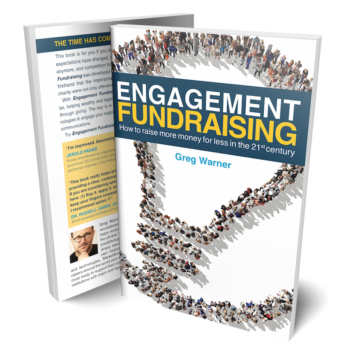We use cookies to ensure that we give you the best experience on our website. By continuing to use this site, you agree to our use of cookies in accordance with our Privacy Policy.
 Login
Login
Your Role
Challenges You Face
results
Learn
Resources
Company
4 types of supporters that self-qualify their interest in being in your portfolio/caseload.


If you’ve been reading this blog for a while, you probably know that I think donor surveys are great for qualifying and prioritizing your supporters for outreach.
You might do some wealth screening before you conduct your survey or try wealth appending after (only adding information to the list that took the survey).
Either way, when they take the survey your supporters will probably categorize themselves accordingly:
Identified supporters
These folks have not yet leaned in. In other words, they have not taken the survey so they are not good leads and most certainly are not ready for outreach. They may meet certain requirements according to basic participation and giving metrics (or wealth screening and predictive modeling), but they are not yet ready to be on a gift officer’s caseload. Therefore, you should try to help them self-qualify by providing opportunities to take a survey again or engage them with another qualification offer.
NOTE: Too many organizations identify donor prospects and hand the list to their gift officers without any qualification. This is a huge mistake because it drives gift officers to spend inordinate amounts of time connecting with donors only to find that most are not qualified. That, in turn, leads to frustration among staff, costs the organization money (time = money), and potentially annoys constituents. Your identified supporter list is a good starting point for qualification. It shouldn’t be used as the end point!
Qualified supporters
Qualified supporters have leaned in and shown interest in supporting your mission even more. They might have taken a survey, spoken to you on the phone, or met with you face-to-face and let you know they were interested in a deeper relationship. By now they’ve answered some qualifying questions to help you understand their interests, passions, consideration stage, and more, including whether or not they have children, would like to give appreciated assets, are interested in supporting your capital campaign, and so on.
You can use this information to rank their potential willingness to consider giving at a high level, and their likelihood to want to build a deeper relationship with you, and when they might want to lean in further or give.
NOTE: Remember, just because a person is wealthy and has given before doesn’t necessarily mean they want to be on your caseload. Wealth doesn’t make them qualified. Once a wealthy supporter answers some discovery questions, they may reveal that they don’t care about your charity as much as the others they support. Don’t fret. Remind yourself that the qualification process is designed to help you prioritize your list.
The goal is efficiency. Disqualification information helps you stay focused. It saves you time and energy (which saves your organization money). It helps you concentrate on others who might welcome your partnership and facilitation. Don’t be afraid to throw a few fish back in the water.
Qualified supporters in cultivation
Once you have qualified and prioritized your supporters, you can begin to cultivate relationships with them. As a result of your qualification efforts, some will require immediate outreach—hot leads. For instance, a supporter might have responded to a survey stating that she is interested in supporting a particular initiative, has no children, is 82 years old, and has appreciated assets she’d like to give.
NOTE: Most leads will be warm and qualified for cultivation, not hot. Now that they’ve self-qualified, it’s important to let them self-navigate the stages of the relationship. Leverage technology with this group to cost-effectively deliver highly relevant, personalized email “touches” that never ask for money but provide value and deliver meaningful content politely and persistently over time.
This will build their trust and help you further qualify them for outreach as they engage over time. Don’t call all of your qualified supporters expecting them to jump at the chance to meet with you. If you have the staff and time available to do that, start by thanking them for taking the survey. Then ask more questions to learn about them. Remember, they leaned in so they’ll be more likely to take your call than identified supporters, but they might not be as highly qualified as “outreach-ready” supporters.
Highly qualified “outreach-ready” supporters
As your supporters’ trust and desire grow over time thanks to your high-value, highly-personalized, meaningful, and highly relevant cultivation, they’ll eventually become ready for you to reach out to them.
NOTE: Interestingly, we have found that recency of engagement is the single best indicator that a donor will accept your call—not their wealth or giving history or even their answers to questions (unless one of those answers implies that you should call right away). Recent engagement (most likely done online) proves that your organization is close to the top of their mind.
Imagine a qualified supporter in cultivation opens your automated email and clicks on the link to view a video. They watch the entire tear-jerking five-minute story about a beneficiary helped by one of your organization’s programs, a program they supported in the past. Don’t you think they will be exponentially more likely to accept your outreach, meet with you, and give again?
Your outreach to those who have engaged deeply won’t be cold. It will be warm. In fact, it may even be hot. Some of your “outreach-ready supporters” might even thank you for your attentiveness, concern, and timeliness. This is the Disney Experience. Why not give it to them?
Caseload supporters
These are the people you have learned truly can make an impact and want to connect with your organization on a deeper level. They want to build a relationship with its mission so they can find meaning in their lives. They also want you to facilitate the connection so they can get the value they want from their giving. They want to work with you to make an impact.
They could become “mega-donors” and a small handful might even develop into truly transformational givers, serious philanthropists giving multi-million dollar donations! These are the folks you want on your caseload.
NOTE: Make no mistake, they don’t just appear out of the blue. The best caseloads are built and refined, and the best fundraisers are artisans who assemble them. Moreover, you should understand that caseload supporters can go quiet for a period of time. That’s why it’s important to monitor their engagement, mostly their digital body language, so you can determine when they become “outreach-ready” once again.
Related Posts:
>>The Four Selfs
>>Are You Ready to Engage
LIKE THIS BLOG POST? LEAVE YOUR COMMENTS BELOW AND/OR SHARE IT WITH YOUR PEERS!
Get smarter with the SmartIdeas blog
Subscribe to our blog today and get actionable fundraising ideas delivered straight to your inbox!
